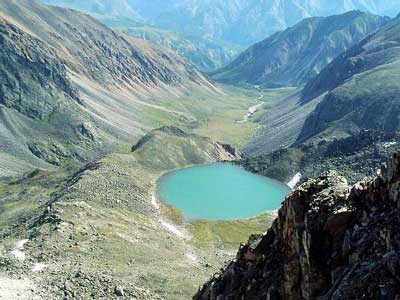NEWS-RELEASES
07.02.2006
Yury Mandaganov - the artist from the Republic of Buryatia. GENERAL OVERVIEW OF BURYATIA.
 The Republic of Buryatia is situated in the center of the Asian Continent extending from the coniferous forests of East Siberia to the wide steppes of Mongolia.
The Republic of Buryatia is situated in the center of the Asian Continent extending from the coniferous forests of East Siberia to the wide steppes of Mongolia. . The capital city of the republic is Ulan-Ude (founded in 1666). There are 6 towns, 29 settlements, and 615 localities in Buryatia. Ulan-Ude is 5519 kilometers away from Moscow and 3500 kilometers away from the Pacific Ocean coast.
. A modern airport and the Trans-Siberian Railway create beneficial conditions for developing an integrated transportation network connecting Buryatia not only to Russian regions and European countries but also to the South Eastern countries. Buryatia occupies a total land area of 351,400 square kilometers and it borders on the southeastern coast of Lake Baikal. 3\4 of Baikal’s coastline lies within the borders of Buryatia's territory.
. The flora and fauna of Baikal are unique. There are more than 2500 species of animals and fish, 250 of which are endemics. Buryatia’s climate is extreme continental. In the South the republic borders on Mongolia, in the East - on the Chita oblast, and in the West - on Tuva Republic.
· Cold winters and hot summers are typical of extreme continental climate. Dry air prevents low winter temperatures from being overly harsh. Summer heat could be felt mostly at midday hours; summer mornings and evenings are quite cool and pleasant. Autumn is long and relatively warm, as, until Baikal freezes, the average autumn temperatures in Buryatia are higher than in Russia’s European regions. Siberian spring begins in late March, but the first verdure does not appear until late April.
· The republic has a very beneficial geographical situation in the system of Russian relations with the countries of the Asian Pacific region.
· The Republic's meso-geographic situation is related to the fact that Zabaikalye (the region east of Baikal) is located in the center of the Siberian and Far East territories that so far have been insufficiently explored.
. This creates necessary premises for establishing in Buryatia a large industrial base of exploration of North and Far East regions, facilitates the development of some branches of machine production, construction materials manufacturing, and of the agricultural/industrial regional complex. However, these advantages of Buryatia's EGS have not yet found their full realization.
CULTURE AND ART.
. Before the annexation of East Siberia to Russia, the vast area on both sides of Lake Baikal belonged to the northern outlying region of Mongolia.
. Over the centuries the nomadic civilization developed its own cultural values, ideals and norms. Like any other civilization, the civilization of nomads knew periods of both prosperity and decline, yet their morality, ethics and spiritual traditions were passed from one generation down to the next one and kept as a timeless cultural heritage. Despite their difficult history, Buryats have always demonstrated benevolence and respect to their neighbors who arrived in the Baikal region at different time periods.
. Cultural, religious and social traditions of different peoples in Buryatia are closely interwoven forming a unique pattern of peaceful coexistence. In this pattern no colors lose their luster, for mutual respect and tolerance are characteristic features of the peoples united by one destiny.
. The heroic epic "Geser," whose 100th anniversary was celebrated in 1995, glorifies the idea of equality and collectivism of the people living on the land of ancestors. At this difficult time period, Geser's land - Buryatia - is one of the few Russian regions that managed to retain its political, national, and religious stability.
The past several years has been a time of revival in Buryatia as old datsans are being restored and new temples and Christian churches are being constructed.
. Today cultural traditions of the peoples in Zabaikalye are closely interlaced, yet the originality of each culture is carefully preserved in all of its aspects, which may be national cuisine, theater, or something else.
. Exhibitions of original pieces of art by local craftsmen who work traditionally with gold and silver; Buddhist icons; paintings which combine the European style with Oriental motifs all testify of the high level of spirituality and education of the bearers of the nation's culture.
(from arhives of the official server of state power bodies of the Republic of Buryatia http://egov-buryatia.ru )

